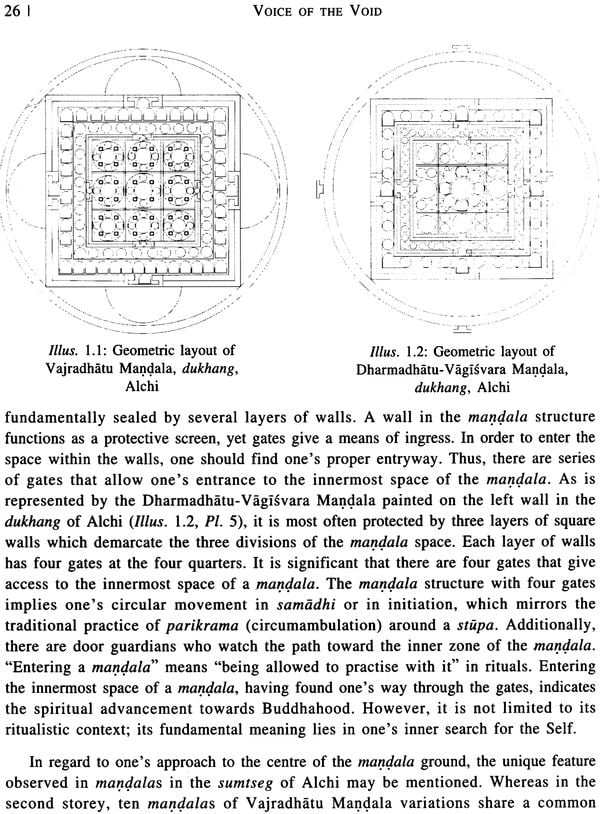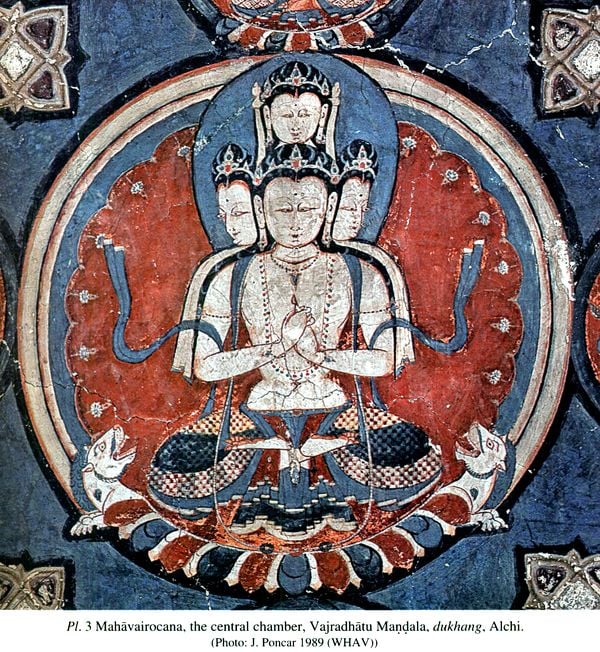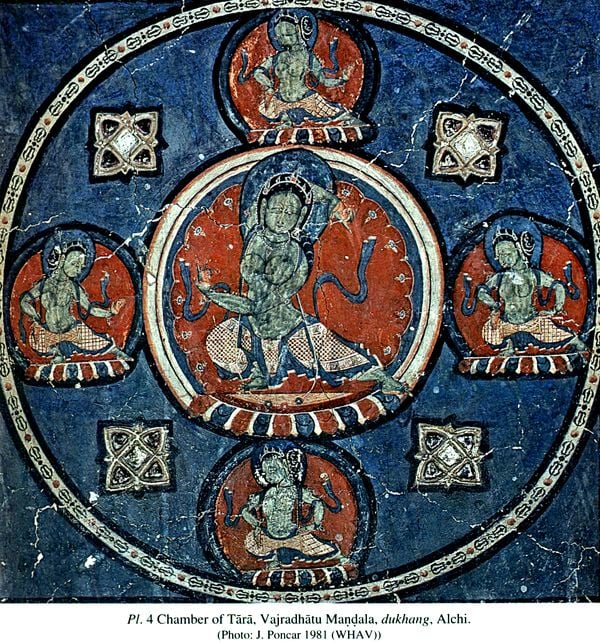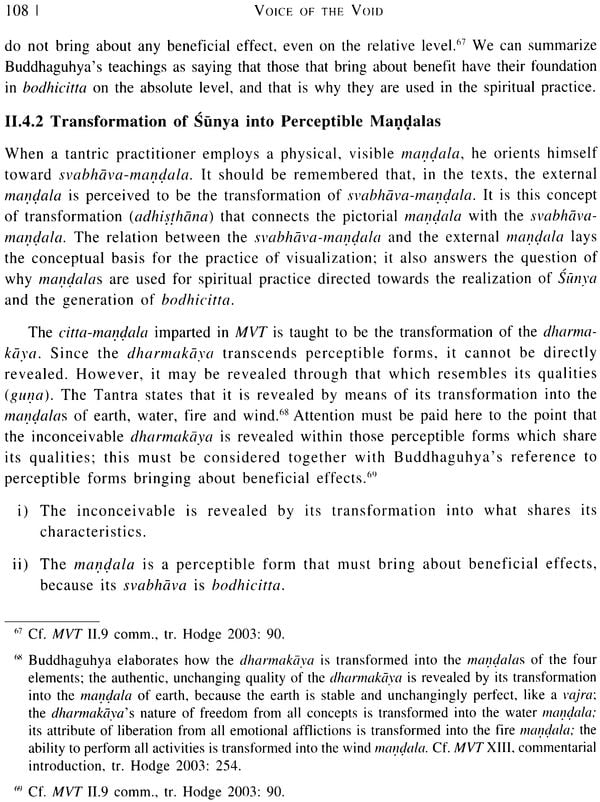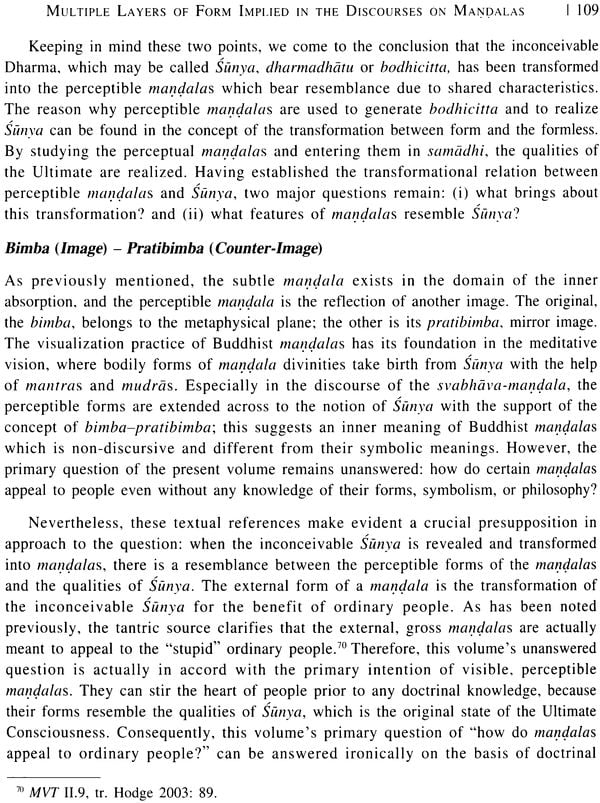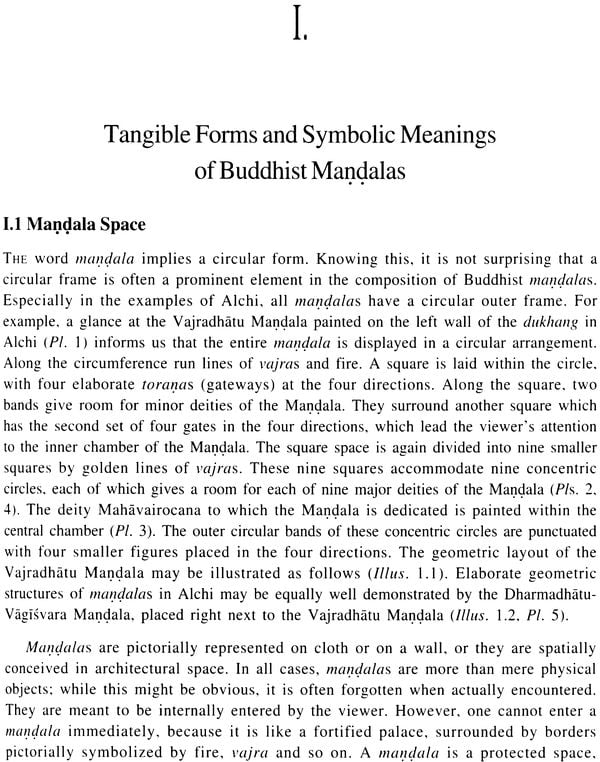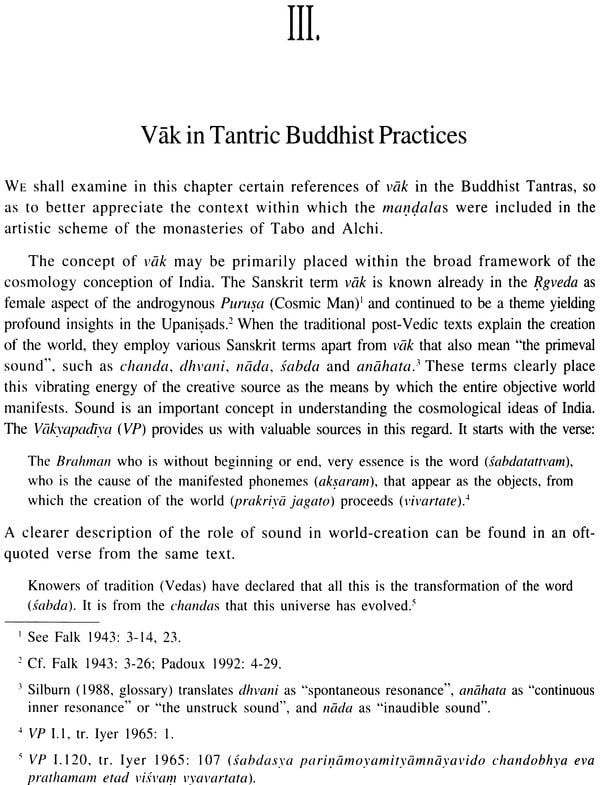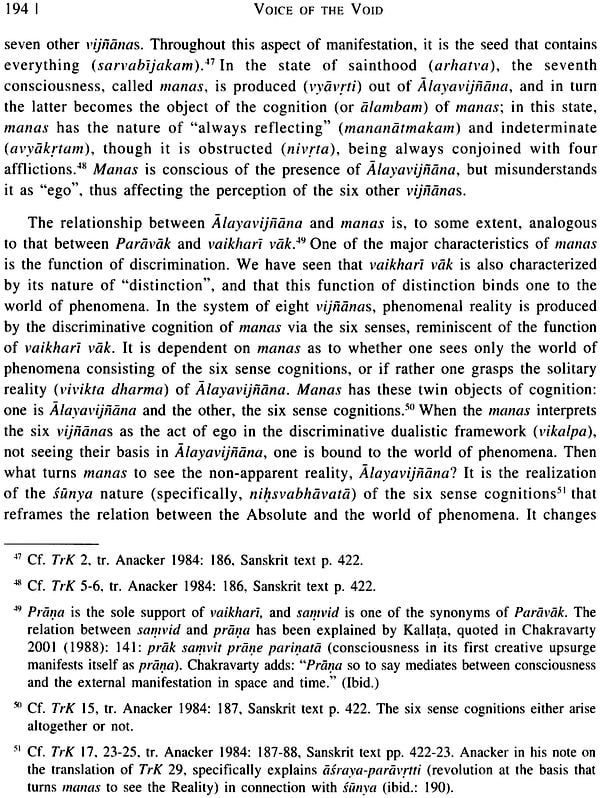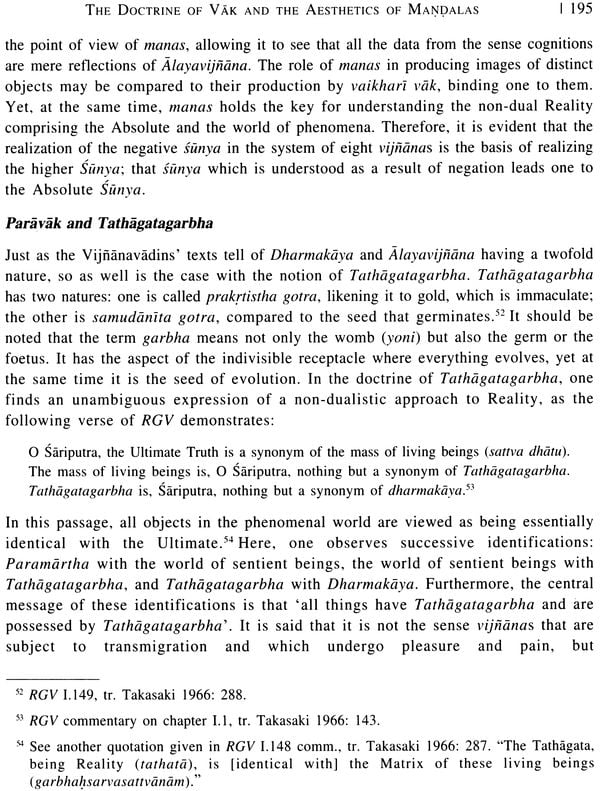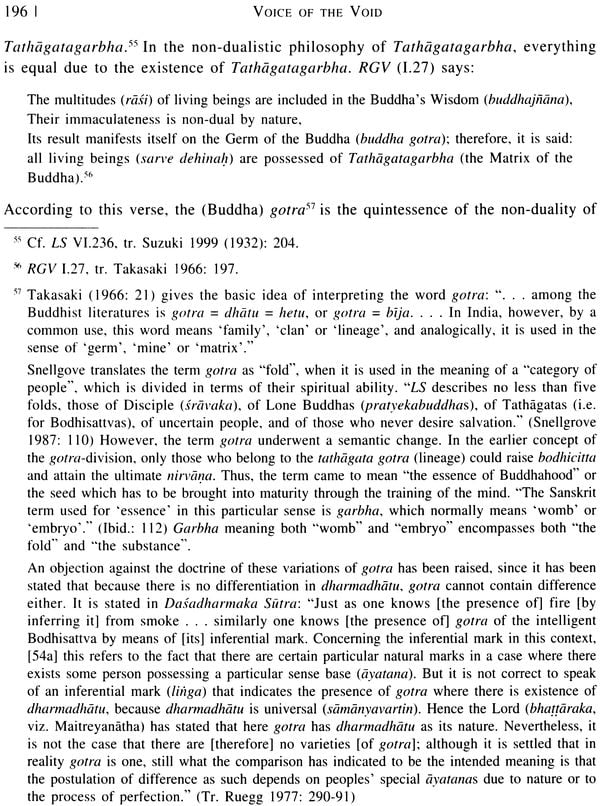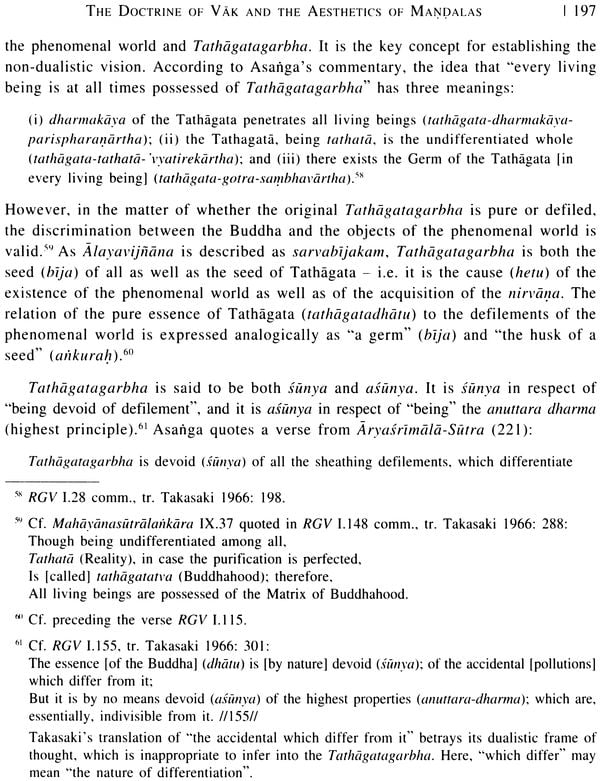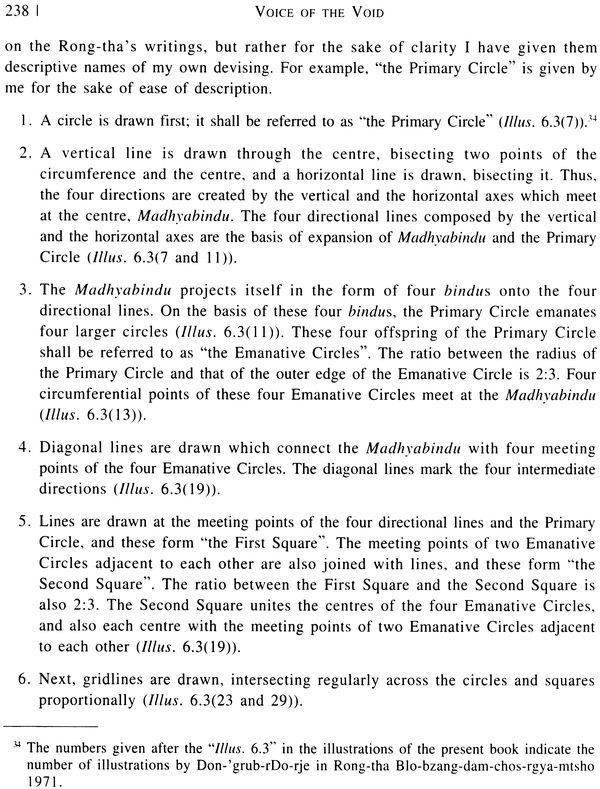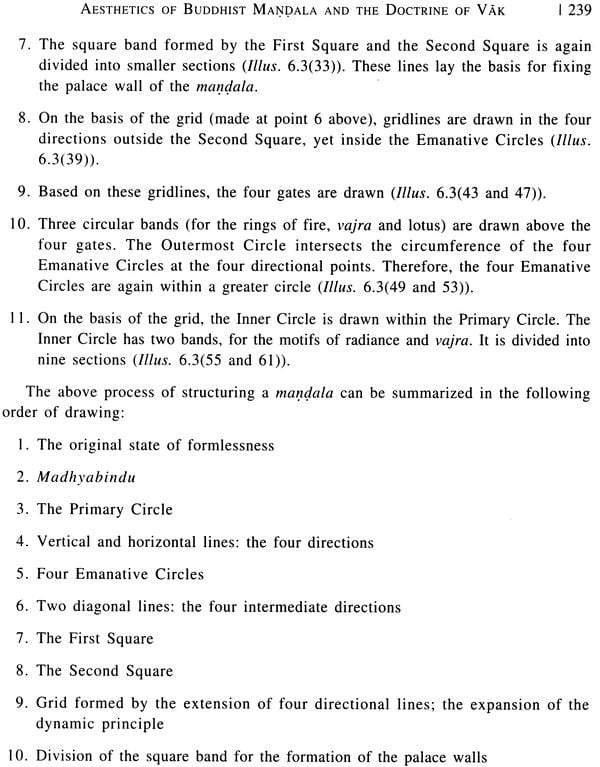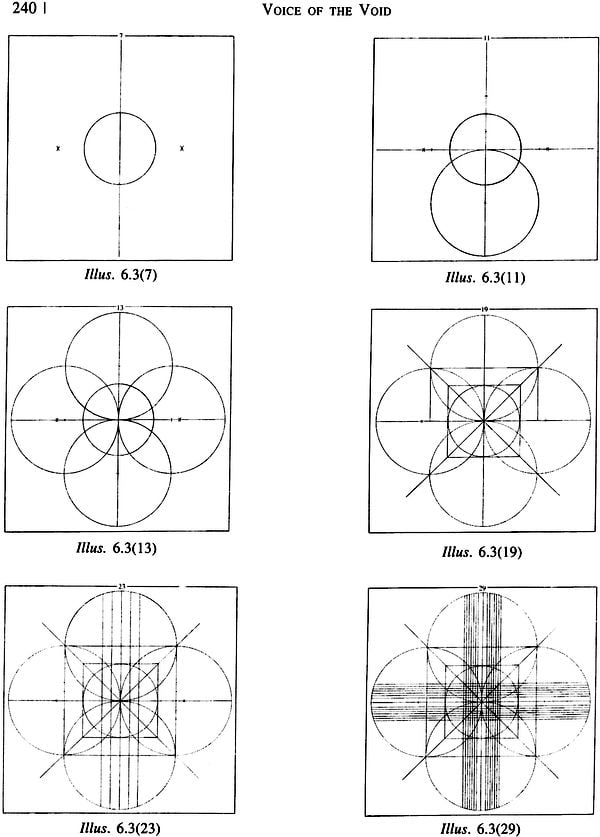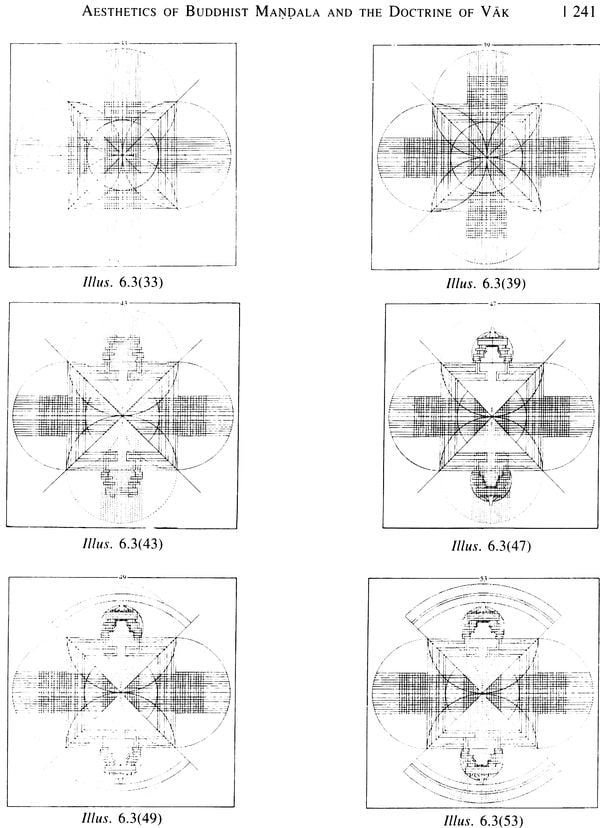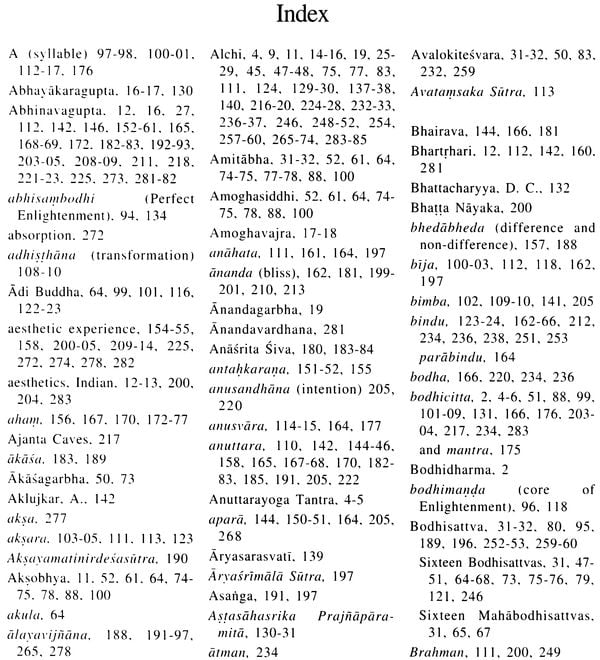
Voice of The Void (Aesthetics of The Buddhist Mandala on The Basis of The Doctrine of Vak in Trika Saivism)
Book Specification
| Item Code: | NAJ938 |
| Author: | Sung Min Kim |
| Publisher: | D. K. Printworld Pvt. Ltd. |
| Language: | English |
| Edition: | 2015 |
| ISBN: | 9788124607565 |
| Pages: | 308 (50 Color Illustrations) |
| Cover: | Hardcover |
| Other Details | 11.5 inch x 8.5 inch |
| Weight | 1.80 kg |
Book Description
About the Book
The research undertaken here about Buddhist 'mandalas is basically designed under the philosophical question how the visible dimensions of forms are related to their invisible contents. The textual sources in reference to Buddhist mandalas teach that the essence of mandalas is sunya (void) and their forms are the reflective images (pratibimba) of sunya. This volume investigates how the colourful form of Buddhist mandalas represents the prime concept of sunya, and what makes these mandalas visually powerful, leaving the impression of "spiritual enhancement" in the heart of people who do not even know about the Buddhist doctrines.
The mandalas permanently represented in the monastic complexes of Tabo and Alchi in the Western Himalayas have been focused in order to examine a prominent role of visual dimensions of mandalas: In order to comprehend mandalas in the context of Buddhist philosophy, the texts of the Yoga- Tantra class have been looked up. Especially, the references to the tantric visualization- practice throw light on the internal experiences with mandalas.
Considering the fact that the Buddhist mandalas have been developed as a method of Mantrayana, being always combined with mantras and mudras, this volume presents the concept of oak (word, subtle sound, voice) as a key to explain how the ultimate state of sunya and perceptible forms of mandalas are related to each other. The doctrine of vak developed in the tradition of Trika Saivism in Kashmir provides us with a systematic way to explain the non-dualism between all phenomenal objects and the Supreme Divine. The doctrine of four levels of vak is examined in the book for the purpose of interpreting the aesthetic phenomena and structuring the different levels of meanings of mandalas from the aesthetic perspective. On the basis of the vak theory, the external forms of mandalas have been explored and their visual principles have been technically analysed, in attempt to answer the question: how do the colourful forms of Buddhist mandalas resemble the formless sunya?
About the Author
Dr. Sung Min Kim, born in Seoul, Republic of Korea, is an artist and scholar on Indian arts. Having completed her Bachelor of Fine Arts in Seoul in 1995, she studied the history of arts in New Delhi and accomplished her doctoral research in the School of Arts & Aesthetics, Jawaharlal Nehru University in New Delhi in 2009. 'She worked on the theme of comparative aesthetics of Kashmir Saivism and Mahayana Buddhism, one of the least studied areas of Indian aesthetics. Living at present in Vienna, she combines the practice of painting and the philosophical research on arts.
Foreword
When I visited the Alchi monastery for the first time, upon entering the Dukhang Hall, I experienced in a flash what this book describes in great detail. I was enveloped by the mandala, so as to enter it and become a part of it, I was drawn into the centre from the periphery, in a process moving from the many forms to the emptiness from which they all spring forth. Once drawn within, the natural effect was to close my eyes, to contemplate in the inner vision (pratibha) what the outer form had just so powerfully manifested. I stayed there for a long time, and when I opened my eyes again, I found a clarity and a confirmation. I was within the mandala, and the mandala was within me. All this arose prior to any analysis of the religious content or the details of the forms.
In a second flash, the idea came to me that the perfection and harmony of these forms had an exact correspondence in the perfection of the thought of a contemporary of the creation of these paintings: Abhinavagupta, the greatest Kashmiri mystic, philosopher, aesthetician of the first millennium. This correspondence fascinated me, because in both cases, the paintings of these mandalas and the great tantric synthesis of Abhinavagupta's work (such as the Tantraloka), their structural consistency and harmony, and the perfection of the detailed execution and expression were perfectly balanced. Neither does the structure overwhelm the beauty of all the parts, nor do the beautiful forms interfere with the overall conception. Part and whole are integrated. They represent in their respective media what the tantric dictum says: sarvau sarvatmakam - "everything is related to the whole", "every part reflects/contains the totality" (and other translations).
These two flashes of insight (pratibha) were spontaneous, not prepared by any detailed study or analysis. But I found them wonderfully confirmed in the study of Sung Min Kim.
The author has requested me to write a foreword to her wonderful book, although I am not a Buddhist scholar or art historian. My qualification lies perhaps in the two areas which the present study embraces. One, the analysis of the principles of Indian art, which I have studied in the Silpasastras, and especially in an extraordinary text which the author also rightly quoted: Vastusutra Upanisad. There the geometric structure of any work of art (be it sculpture" painting, architecture) is given its full symbolic value, a value of which the traditional artists were deeply aware. The importance of the line, the point (bindu), the circle, etc. and their cosmic significance is hinted at in that text, thus making the sacred art a "mecrcosm" between the microcosm of the body and the macrocosm. The same basic principles are relevant to Hindu and Buddhist art.
The second area is that of the Trika and Pratyabhijna, commonly called (non-dualist) Kashmir Saivism, with its great tantric exegesis. I was always convinced that the philosophy underlying the aesthetic concepts and principles of Abhinavagupta apply not only to poetics and dramaturgy, but to visual arts as well.'
Sung Min Kim has made a great contribution to overcoming the dichotomy between the visual and the spoken or written word, between form and language. Form is another kind of language, with its "grammar", "syntax" and poetry. That these are not vague ideas of correspondences but rather can be precisely related is the content of the present book.
The author has based her analysis of the mandalas of Tabo and Alchi, the great monasteries of Spiti and Ladakh, on the pervasive theory of Yak and its four stages - para, pasyanti, madhyama and vaikhari - and she has done it so convincingly. It is in the framework of this philosophy of language, as originated from Bhartrhari, contained in the Agarnas, and fully developed by Abhinavagupta, that the analysis of the relation hip between the Form and the Formless, the differentiated and the undifferentiated can be meaningfully placed.
The present study effectively combines what is required for the understanding of such complex sacred art as Buddhist mandalas: a knowledge of the texts (Sanskrit and Tibetan), the philosophy and the religious-spiritual background, aesthetic principles and artistic execution. Being an artist herself, trained in Indian art history and aesthetics, Sung Min Kim fulfils these core disciplinary requirements. Therefore her interpretation is based on aesthetic perceptivity and a deep understanding of the relationship between form and meaning. But more than that, the important contribution of her work is the bringing together of two traditions, Buddhism and Saivism, and of two methodologies, related to "word" (vak) and to painting and sculpture. Kashmir was a melting pot of religious, philosophical and artistic traditions around the beginning of the first millennium, and the interactions and influences between Saivism and Buddhism contributed to their mutual development. Thus, the historical proximity of Abhinavagupta to the two great monasteries of Tabo and A1chi makes this attempt both valid and relevant.
Sung Min Kim has negotiated the difficult task of doing justice to both the aesthetic and the religious aspects of the Buddhist mandalas. She has taken into account the artistic quality without neglecting the spiritual dimension, and placed both of them in the overall scheme of the four levels of vak, since in both cases it is a question of manifestation out of the Unmanifest. Her interpretation is convincing, because such detailed analysis is not found in the field of the visual arts as it is in the context of language. Placing the Alchi mandalas in the level of sthula pasyanti (the gross form of the Visionary Word) is a stroke of genius. Pasyanti is the level of consciousness and of vak which encompasses all in one act of vision, without being dependent on time sequence or analysis of details. It is thus close to the Supreme (Para) which would correspond to sunya in Buddhist thought. When pasyanti manifests at the level of form (sthula) - whether in sound or in visual forms - it mediates between the Ultimate and the manifestation. This accounts for the intuitive, simultaneous vision of a mandala before its component parts are comprehended or have become the object of ritual. In sthula pasyanti the form comes close to pure consciousness (samvid), hence leading to a state of identification. The author shows the correspondence of samvid in Saivism to dharmadhatu in Buddhism, as manifest in Mahavairocana. In her interpretations the synaesthetic often plays a role, relating to a transformation of the visual as sound (as with nada and the like).
Without going further into the content of the present work, I want to stress its originality, opening new vistas in the interpretation of sacred art - and not only for Buddhist mandalas, which are particularly apt at presenting what the author calls "the essence" (dharmadhatu). I am sure that the book will contribute to a deeper understanding of Buddhist art in both its aesthetic and spiritual content.
Preface
It was about twenty-two years ago (in 1992) when I first witnessed the great ritual of Heruka Mandala in Leh, in Ladakh, India. At the time I was an art student and my trip to India was triggered by a rather vague question about the meaning of artistic creations. My encounter with the ritual of sand-mandala was unexpected and indeed overwhelming. First of all, the ritual of mandala that was accompanied by the mantra recitation and mudras had shaken my senses with their strong aural and visual powers. I was enraptured in the current of colourful visuals and penetrating sounds throughout the ritual that continued over the course of ten days. Above all, the final dissolution of mandala into a flowing river after such an elaborate construction of the colourful form had given me the idea about what "the arts" should stand for: I thought I have been the truest form of art. The impression of mandala was so strong that I wanted to write an essay about it, when I returned to Korea after the journey. However, I could not grasp the topic, despite that, during the ritual, I had written some notes with technical descriptions; the subject was too formidable to be dealt within an essay. Moreover I had no knowledge either about the background or the philosophy of mandala. However, my personal experience of the mandala ritual in Leh and the mural paintings of mandalas in the monastery of Alchi spoke about its profundity. I started researching the symbolic and religious meanings of mandalas. At that stage, I was mainly concerned about the question of the relation between the concepts and the forms; however, I realized in due course that it is not the symbolic contents of mandalas that make mandalas visually powerful. Several years of research led me to the point of view that the deeper nature of mandalas cannot be explored without touching upon the dimen ions beyond concepts and symbols.
Buddhist mandalas have been primarily dealt with in the context of religious practice. They have been understood as a design which helps the practitioner in exploring the inner realm during the rituals. It is said that the subtle forms of mandalas re-created in the mind lead one to the core of mandalas. The symbolic dimension of mandalas has been doctrinally laid out in the visualization method of tantric practices wherein the external figures of a mandala are, one by one, held in the mind and those mental images gradually lead one to the realization of the Void (Sunya). However, the technique of visualization is not known to ordinary people. In spite of their ignorance of the visualization technique, non-practitioners also respond intensively to the visuals of mandalas, especially if mandalas are accomplished by a high standard of arts. The response of non-practitioners cannot be simply named as the realization of bodhicitta (mind of enlightenment), karuna (compassion) or sunyata (the void), as is formulated for the tantric practitioners. Non-practitioners would not interpret their own experiences in such doctrinal terms, when mandalas are spontaneously re-created in the mind. These internal images leave an impression of "spiritual enhancement" in the mind, which I define as "aesthetic". The present volume investigates the phenomenon of how the Buddhist mandalas speak to the heart, and from where their aesthetic power originates.
Most of this work has been completed for my doctoral thesis under the supervision of Prof. H.S. Shivaprakash in the School of Arts and Aesthetics, Jawaharlal Nehru University, New Delhi. It is only thanks to Prof. Shivaprakash that my quest for the meaningful visuals has been encouraged and possibly taken into a fruit.
I must above all express gratitude for the help and critical comments received from Dr. Ernst Furlinger. From the initial stage of the conception till the final refinement of the writings, he shared his knowledge about the subject and provided me with treasuries of research sources. Conversations with him stimulated me to carry on the research with enthusiasm and made me look at the subject from different angles. His critical comments helped me in organizing my fragmentary thoughts into a structure. I thank Dr. Bettina Baumer in having read through my unripe synopsis and given me helpful comments. Also, I must express thankfulness to her for introducing the field of Trika Saivism to me and for helping me out in comprehending the verses from the old texts. I must equally express my gratefulness to Dr. Christian Luczanits for giving me a number of practical guidance in regard to the researches on the sites of Tabo and Alchi. I appreciate his scholarly quality and great generosity that were proved by his detailed comments on my unorganized draft. I am grateful to Prof. Lokesh Chandra for his generous help in the matter of textual understanding of Buddhist mandalas. He generously shared his erudition and years of researches on mandalas with me. I should not forget to thank the late Prof. Ramachandra Gandhi for helping me in relating my theoretical search with the creative activity of paintings. His questions about my paintings and academic interests stirred me to bring forth the question about the relationship between form and formlessness - which was the original title of the thesis - from its dormant state within my consciousness. I also owe thanks to Dr. Kapila Vatsyayan whose presence and writings have been a continuous inspiration for my research and to Dr. Lolita Nehru who taught- me how to write and how to organize ideas.
I must express my gratefulness to Geshe Tsewang Dorje of the Ngari Institute of Buddhist Dialectics in Ladakh for accepting my request for his personal instruction on the practice of tantric visualization. His compassionate teachings were extremely helpful in understanding the descriptions of the practice given in the old texts. I also thank Genla Takpa ligmet of the Spituk monastery in Ladakh for sharing his understanding of visualization. I thank the monks of the Tabo monastery, especially Lama Urgyen Angrup, for explaining me the revived ritual of Vajradhatu Mandala and Lama Sonam for helping me at the site of the research.
I gratefully acknowledge the staff in the Western Himalaya Archive Vienna, for providing me with valuable visual materials during my research period; the Jawaharlal Nehru Memorial Fund for having financially supported my doctoral research; Mr Tsering Wangchuk of Archaeological Survey of India, Leh, for his assistance. I also express my gratitude to Anil Pawar for his help in many practical matters during the research. I thank my parents for encouraging me all the way through the research. The equal gratitude should be expressed to my friends in Austria, especially Anni, Christa, Hemma and Fransiska for their constant help and love.
I would like to express special thanks to Dr. Jaroslav Poncar for the permission to publish his photographs and to Dr. Christian Luczanits who has not only granted me permission to use his photographs but indeed provided most of materials for the plates in this book. And with extreme gratitude I must mention the name of Michael lanuzielo for his painstaking proof-reading and language correction.
I dedicate the book to my husband Ernst and our little daughter Yu Zin.
Introduction
The central question of this work concerns, in a broad framework, the relation between the forms taken in the visual arts and their innate meanings embedded within. This research has been undertaken with the question of how the visible dimensions of artistic forms are related to their invisible dimensions. The invisible dimensions of visual forms are experiential in the arts, and their vital presence unfolds in both the process of artistic creation and in aesthetic relish. While we discuss the inlaid meanings of visual forms, we are naturally confronted with important questions: what is meant by the "embedded content"? Is this a symbolic implication or perhaps a metaphorical connotation?
From the outset, it should be discerned that there is a non-discursive meaning as well as discursive meanings that are charged into visual forms. I for example, the symbolic or metaphorical meanings of visual elements given in the fold of religious doctrines should be categorized as discursive meanings. The non-discursive layer of visual forms might merely be glimpsed in a flash, as we see in artists' inspirations that result in the creation of new forms. For the purpose of investigating into the nature of forms and their relationship to the invisible dimensions of these forms, this volume focuses on Buddhist mandalas, because they are as profound and multi-layered in their content as they are elaborate and rich in form. Mandalas have been a perennial theme in the religious arts of India, and became even more elaborate in both form and concept in their Buddhist context." The forms of Buddhist mandalas are traditionally laid down on the basis of the vision attained at the state of the absorption into the non- conceptual world. The term mandala designates different objects according to the context. It may refer to the system of bodily cakras wherein deities reside; or the secret ritual meeting of tantric initiates and yoginis (melaka) where the participants usually form a circle; the ritual mandala seen during the initiation; or even one's own body in the process of tantric yoga. Mandala considered in this volume is limited to those visual objects permanently represented in the monastic complex and meant to be seen by the public during worship. The Buddhist mandalas are generally characterized in the form of geometric structures with clear indications of the centre and the four cardinal directions; and the divinities are either represented in anthropomorphic forms or in symbolic forms, and are arrayed in a hierarchical order around the centre within the geometric layout.
The Question of the Relationship Between Forms and the Formless
Before discussing the question of visual forms and their inner content in Buddhist mandalas, let us consider one concern found in the study of Buddhist arts: although the Ultimate Reality is defined Sunya (Void), the Buddha that is the emblem of the Ultimate Reality, is also conceived in the form of the human body. One may see a contradiction in Buddhists' bowing down to Buddha images at the altar yet averring that the Buddha resides in one's own mind, not in the external images. However, it is not to the physical form, but rather to the spirit of the Buddha that devotees bow down. The physical form of the Buddha is placed at the altar in order to remind people of their own bodhicitta (awareness of enlightenment) and to mirror the Buddha in their heart. Another example would corroborate the suggestive characteristics of Buddhist images. Among the Buddhist communities of East Asia, the portrait of Bodhidharma, the first patriarch of Zen tradition, is revered and believed to have spiritual power; thus, monastic painters of the Zen tradition often draw his portraits. When they draw his portrait, it is not the beautiful face of Bodhidharma but the spirit imbued in his face that they feel challenged to draw. These two examples may typify the non-discursive meaning of visual forms embedded in the expression of Buddhist arts.
If we talk about form in the context of Buddhism, first of all, we are reminded of the great affirmation of Mahayana Buddhism: "rupa (form) is sunya, and sunya is rupo",' This assertion concisely exposes the non-dualistic foundation of Buddhist arts: the formless can be expressed by means of forms. The elaborate form of the Buddhist mandala is, in concept, meant to represent Sunya. But, how can we prove it or experience it? The Sanskrit word mandala, literally meaning "the circle", is the combination of two words manda (Tib.: dkyil) and la (Tib.: kor), respectively denoting "the chief divinity and the emanation" or nirvana and samsara: Thus, we notice that the term itself contains the two counterparts: the formless Ultimate and multiple forms. The ritual concerning the creation of a sand-mandala explicitly expresses the ideal of Sunya, when the mandala is destroyed to be dissolved in the flow of a river at the final stage of the ritual. However, how does Sunya, the Buddhist term for the formless Ultimate, have anything to do with the colourful forms of mandalas that are permanently painted on the walls of ancient monasteries and which have been preserved up to now? The question which is first encountered in regard to Buddhist mandalas is how the bodily figures and primary colours in mandalas can be consistent with formless Sunya. When facing colourful mandalas on the wall of these ancient monasteries, one is in a difficult position to understand the Buddhist ideal of Sunya: these mandalas seem contrary to "the Void" at the first glance. I, personally, had been struggling with the fact that Buddhist monasteries are filled with images, golden statues and colourful paintings, which, I felt, were contradictory to the Buddhist ideal of Sunya. Nevertheless, one thing is clear: if the employment of colourful forms was contradictory to the quest for Sunya, the presentation of colourful forms simply would not have been the perennial tradition of Buddhist art. Here, we must return to the Buddhist affirmation: rupa is sunya, and sunya is rupa. Colourful forms are present in Buddhist monasteries as a self-evidence of the non-dualism between forms and the formless, and what we investigate here is the question of these colourful forms of mandalas and their relation to Sunya.
Buddhist Mandalas in the Context of the Religious Practice
The symbolic meaning of Buddhist mandalas in the context of religious practice has been concisely expressed by David L. Snellgrove, a scholar of Indo- Tibetan Buddhism:
Mandla, the primary function of which is to express the truth of emanation and return tsamsara and nirvana), is the centre of the universe .... Its core is Mt. Meru: it is the palace of the universal monarch, it is the royal stupa; it is even the fire altar where one makes the sacrifice of oneself.
His words express the cosmic significance of mandalas. In this text, two essential concepts of the mandala are implied: the centre and its transformations. However, not all mandalas are charged with cosmic meanings. Depending on the main divinity represented in the centre, the purpose and the meaning of mandalas vary. For example, the mandala of the eight Nagas is for pacifying the venom of snakes;" an interpretation of overt cosmic symbolism is hardly appropriate for this mandala. In his commentary on the Sarvadurgatiparisodhana Tantra-; Buddhaguhya remarks that each mandala i designed for different purposes.' Thus, one should clearly understand that the cosmic symbolism with an emphasis on "the centre and its transformation" is apt only when we deal with mandalas of divinities who represent the Absolute. For instance, the mandalas of Tabo and Alchi that are the main objects of the investigation in this book are centred on Mahavairocana, who represents "the great illumination of Enlightenment" and "the absolute body of Dharma". Thus, these mandalas are charged with cosmic significance, involving such concepts as Dharmadhatu (Ultimate Dharma), Sunya and Bodhicitta. As a ritualistic tool, Buddhist mandalas mainly serve the practice of visualization. However, not every Buddhi t is eligible to practice the visualization of mandalas. First of all, one should be properly initiated in order to carry out the mandala practice. In the Tibetan Buddhist tradition, the practitioners are assigned according to their spiritual ability to particular mandalas that are categorized into four groups. These four categories of mandalas correspond to the Tibetan classifications of Buddhist Tantras: Kriya, Carya, Yoga and Anuttarayoga. Because Anuttarayoga Tantras mark the predominant stream of Tibetan Buddhi m today, it is mainly the divinities of Anuttarayoga Tantras who are nowadays employed for mandala practices. Thus, only spiritually advanced monks are said to be able to carry out mandala practice.
Let us examine how the forms and the formless dimension of mandalas are conceived by religious practitioners. For monks who practise with mandala images, the pictorial mandalas are not real mandalas: they are merely reflective images (pratibimba). The real mandala, which is the "Essence"," must be internally explored. During an interview I carried out in Ladakh in July 2007 in order to survey what mandalas actually mean for contemporary Buddhist practitioners, Geshe Tsewang,? a practitioner of Heruka Mandala, said:
When the external mandala is successfully internalized, the way how to practise mandala is revealed.
His statement confirms that the complicated external forms are not all about mandala, and there are deeper dimensions to be explored, Unless the real mandala is tasted, one could not know what the visual mandala is merely by seeing it. Geshe Tsewang actually used the expression of "tasting a mandala" to indicate its inner sensual experience. It is remarkable that a religious practitioner used the terminology of Indian aesthetics in explaining his spiritual experience, being unaware of what rich history the concept of "tasting" (rasa) has undergone in Indian aesthetics. The use of the metaphor, "tasting a mandala" by a religious practitioner is particularly significant in dealing with the aesthetics of Buddhist mandalas.
Buddhist mandalas are taught to be the representation of Sunya: the essence of mandalas is Sunya and their forms are reflective image (pratibimba) of Sunya. It is said that realizing Sunya of the self should precede the visualization of a mandala. From Sunya of the self, the deity is generated as the self. In visualization, the self becomes a divinity through Sunya and returns to the self through Sunya, and the deity of mandala appears in Sunya and disappears into Sunya. The practice of Sunyata, Bodhicitta and Karuna (compassion) should precede the practice of mandalas, and the Buddhist practice of mandalas is essentially meant to strengthen the realization of the Truth that is Sunya. Thus, the Hevajra Tantra (HT), an Anuttarayoga Tantra says:
Bodhicitta which has both absolute and relative forms should be generated by means of the mandala Circle, etc. (mandalacakradi) and by the process of Self-empowerment (svadhistanakrama).
HT succinctly explains about the essence of mandala from the religious perspective. HT further teaches that mandala is the essence which has the nature of void (kha) and purifies the sense faculties; thus Bodhicitta is cultivated through mandala." Mandalas are also said to be the abode (puram) of the essence of all the Buddhas (sarvabuddhatmakam) and bears the great bliss (mahat sukham)." We see a clear notion in HT that mandalas are defined to be the Essence (saram) or Bodhicitta. At the same time, they are the means to realize the Essence or Bodhicitta. Thus, we observe that, in religious practice, the notion of Sunya combined with the concept of Bodhicitta is symbolically implied in the visual images of Buddhist mandalas.
Contents
| | Prologue | xi |
| | Foreword | xix |
| | Preface | xxiii |
| | Abbreviations | xxvii |
| | List of Plates | xxix |
| | List of Tables | xxxiii |
| | List of Illustrations | xxxv |
| | Introduction | 1 |
| I. | Tangible Forms and symbolic meanings of Buddhist Mandalas | 25 |
| I.1 | Mandala Space | 25 |
| I.2 | Mandala Deities | 46 |
| I.3 | Colour | 78 |
| II. | Multiple Layers of Form implied in the Discourses on Mandalas | 83 |
| II.1 | Mandala in Association with the Notion of Trikaya and Triguhya | 83 |
| II.2 | Multiple Layers of Form in Mandalas | 90 |
| II.3 | Practice of Visualization | 96 |
| II.4 | Non-dualism of Form and the Formless in the Practice and Theory of Buddhist Mandalas | 105 |
| III. | Vak in Tantric Buddhist Practices | 111 |
| III.1 | Buddhist Practice of syllables | 113 |
| III.2 | The Highest Divinity Conceived in the Nature of Sound | 117 |
| III.3 | Association of Goddess Prajnaparamita with Vak | 124 |
| IV. | The Doctrine of Vak in Trika Saivism | 141 |
| IV.1 | Four Levels of Vak | 142 |
| IV.2 | Vak in Mantra Practice | 173 |
| V. | The Doctrine of Vak as a Theoretical Basis for understanding the Aesthetics of Mandalas | 182 |
| V.1 | Paravak and Sunya | 182 |
| V.2 | The Non-dualism of Creation and Concealment within the Doctrine of Vak | 199 |
| V.3 | Sanctification of Mandalas on the Basis of the Doctrine of Vak | 201 |
| V.4 | Gross, Subtle and Transcendental Forms of Vak | 204 |
| V.5 | Transformation of Form in the Doctrine of Vak | 207 |
| VI. | Establishing the Aesthetics of Buddhist Mandala on the Basis of the Doctrine of Vak | 216 |
| VI.1 | Redefination of Mandalas from the Perspective of the Vak Theory | 216 |
| VI.2 | Mandalas of Alchi Interpreted as the Gross Pasyanti | 220 |
| VI.3 | Visual Elements of Gross Pasyanti in the Mandalas of Alchi | 226 |
| VII. | Aesthetic Power of the Mandalas of Alchi | 272 |
| VII.1 | Immersion into the Pasyanti vak | 272 |
| VII.2 | Aesthetic Viewing of Mandalas | 274 |
| | Conclusion | 283 |
| | Bibliography | 286 |
| | Index | 303 |
| | | |
